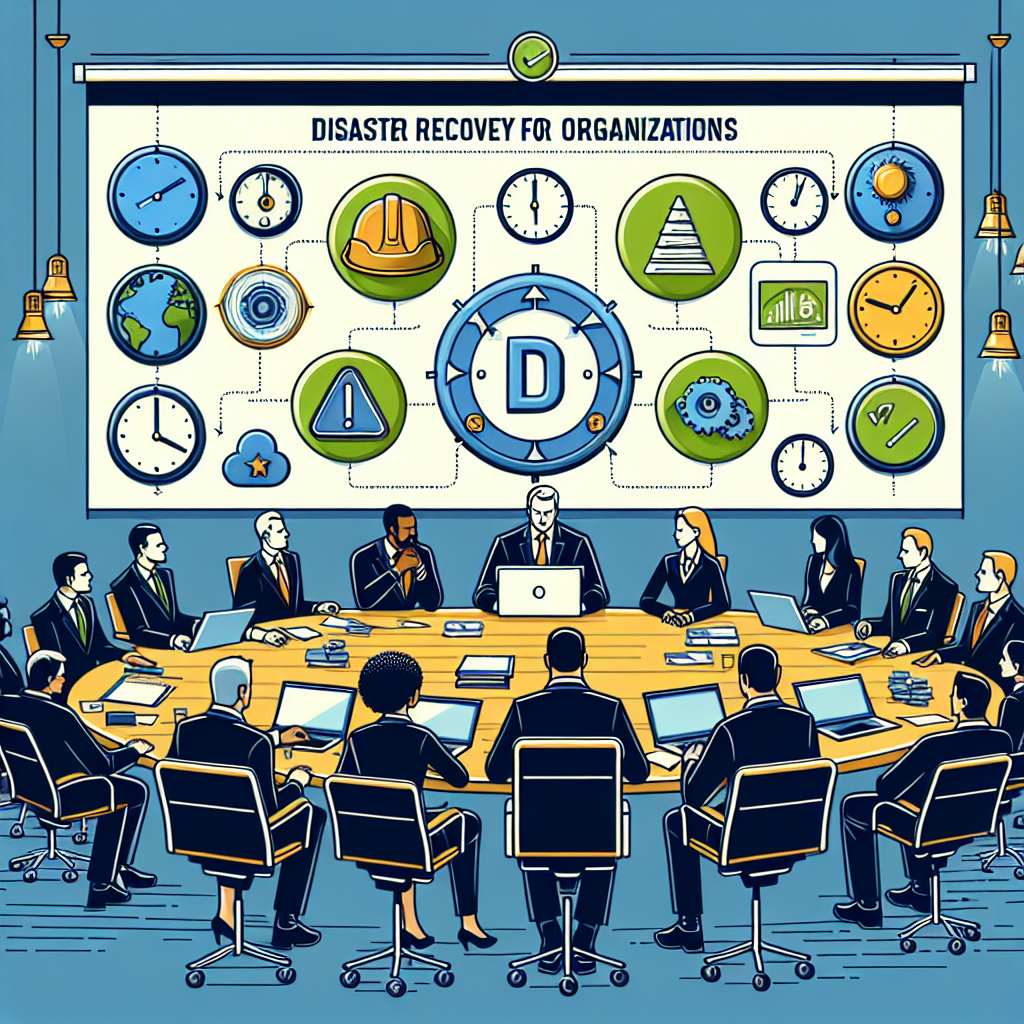Your cart is currently empty!
Tag: Organizations

How Managed Services Can Improve IT Efficiency in Large Organizations
Managed services are becoming an increasingly popular option for large organizations looking to improve their IT efficiency. By outsourcing the management of their IT infrastructure to a third-party provider, companies can free up valuable resources and focus on their core business activities.One of the key ways in which managed services can improve IT efficiency in large organizations is by providing access to a team of experienced professionals who specialize in managing IT systems. These experts have the knowledge and skills necessary to quickly identify and resolve issues, minimizing downtime and ensuring that systems are running smoothly at all times.
Managed services also offer round-the-clock monitoring and support, meaning that IT issues can be addressed immediately, rather than waiting for in-house staff to come in the next day. This proactive approach to IT management can help prevent potential problems from escalating and causing disruptions to business operations.
In addition, managed services providers often have access to the latest technology and tools, allowing them to implement best practices and optimize IT systems for maximum performance. This can lead to cost savings for organizations, as they no longer have to invest in expensive hardware and software upgrades themselves.
Another benefit of using managed services is scalability. As organizations grow and their IT needs evolve, managed services providers can easily scale their services to meet changing requirements. This flexibility allows organizations to adapt quickly to market changes and stay ahead of the competition.
Overall, managed services can significantly improve IT efficiency in large organizations by providing access to a team of experts, round-the-clock monitoring and support, access to the latest technology, and scalability. By outsourcing their IT management to a third-party provider, organizations can focus on their core business activities and achieve greater success in today’s competitive business environment.

Ensuring Business Continuity in Times of Crisis: Best Practices for Resilient Organizations
In today’s fast-paced and unpredictable business environment, organizations must be prepared to face unexpected crises that can disrupt their operations. From natural disasters to cyberattacks, from pandemics to economic downturns, there are a myriad of potential threats that can jeopardize a company’s ability to function effectively. In order to ensure business continuity in times of crisis, organizations must adopt best practices that will help them build resilience and weather any storm that comes their way.One of the key best practices for ensuring business continuity in times of crisis is to develop a comprehensive business continuity plan. This plan should outline the steps that the organization will take to ensure that essential functions can continue even in the face of a crisis. It should include detailed procedures for responding to different types of emergencies, as well as a clear chain of command for decision-making during a crisis. Regularly updating and testing this plan is crucial to ensure that it remains effective and relevant in the event of a crisis.
Another important best practice for resilient organizations is to invest in robust IT infrastructure and cybersecurity measures. In today’s digital age, cyberattacks are a constant threat to businesses of all sizes. By implementing strong cybersecurity protocols and investing in secure IT systems, organizations can minimize the risk of a data breach or other cyber incident that could disrupt their operations. Regularly backing up data and implementing disaster recovery measures are also essential components of a strong IT infrastructure that can help ensure business continuity in times of crisis.
Effective communication is another critical best practice for ensuring business continuity in times of crisis. During a crisis, clear and timely communication is essential to keep employees, customers, and other stakeholders informed and engaged. Organizations should establish communication protocols and channels in advance, so that they can quickly disseminate important information when a crisis occurs. Maintaining open lines of communication with employees and stakeholders can help build trust and confidence in the organization’s ability to weather the storm.
Finally, building a culture of resilience within the organization is key to ensuring business continuity in times of crisis. This includes fostering a mindset of adaptability, creativity, and collaboration among employees, as well as creating a supportive work environment that encourages innovation and problem-solving. By cultivating a resilient culture, organizations can better navigate and overcome the challenges that arise during a crisis, and emerge stronger and more prepared for future challenges.
In conclusion, ensuring business continuity in times of crisis requires a proactive and strategic approach that incorporates best practices for resilience. By developing a comprehensive business continuity plan, investing in IT infrastructure and cybersecurity, maintaining effective communication, and building a culture of resilience, organizations can better prepare themselves to face and overcome any crisis that comes their way. By implementing these best practices, organizations can safeguard their operations, protect their reputation, and ensure their long-term success in an increasingly uncertain world.

The ABCs of Disaster Recovery: A Comprehensive Guide for Organizations
Disasters can strike at any moment, causing chaos and disruption to businesses of all sizes. Whether it’s a natural disaster like a hurricane or earthquake, or a man-made disaster like a cyber attack or equipment failure, having a solid disaster recovery plan in place is essential for organizations to minimize downtime and ensure business continuity.The ABCs of disaster recovery refer to the key components that organizations need to consider when creating a comprehensive disaster recovery plan. By following these steps, organizations can better prepare for and recover from disasters, ensuring that they can continue to operate and serve their customers even in the face of adversity.
A – Assess Risks: The first step in creating a disaster recovery plan is to assess the potential risks that your organization faces. This includes identifying potential threats, such as natural disasters, cyber attacks, or equipment failures, and understanding the potential impact that these events could have on your business operations. By conducting a thorough risk assessment, organizations can better prioritize their disaster recovery efforts and allocate resources effectively.
B – Backup Data: One of the most critical components of a disaster recovery plan is ensuring that your organization’s data is backed up regularly and securely. This includes backing up both on-site and off-site, as well as implementing data encryption and other security measures to protect sensitive information. By regularly backing up data, organizations can minimize data loss in the event of a disaster and ensure that they can quickly recover and resume operations.
C – Create a Continuity Plan: In addition to backing up data, organizations should also create a business continuity plan that outlines how they will continue to operate in the event of a disaster. This plan should include detailed procedures for responding to different types of disasters, as well as communication protocols for keeping employees, customers, and other stakeholders informed. By having a solid business continuity plan in place, organizations can minimize downtime and ensure that they can quickly recover and resume normal operations.
D – Determine Recovery Time Objectives: Recovery time objectives (RTOs) are the maximum amount of time that an organization can afford to be without certain critical systems or services. By determining RTOs for different systems and processes, organizations can better prioritize their recovery efforts and allocate resources effectively. This helps ensure that critical systems are restored quickly, minimizing the impact of a disaster on business operations.
E – Establish Recovery Teams: Finally, organizations should establish recovery teams that are responsible for implementing and executing the disaster recovery plan. These teams should include key stakeholders from across the organization, as well as external partners and vendors who can provide support and expertise during a disaster. By having dedicated recovery teams in place, organizations can ensure a coordinated and effective response to disasters, minimizing downtime and ensuring business continuity.
In conclusion, the ABCs of disaster recovery provide organizations with a comprehensive guide for creating a solid disaster recovery plan. By following these key steps, organizations can better prepare for and recover from disasters, ensuring that they can continue to operate and serve their customers even in the face of adversity. By assessing risks, backing up data, creating a continuity plan, determining RTOs, and establishing recovery teams, organizations can minimize downtime and ensure business continuity in the event of a disaster.

From Risk Management to Business Continuity: Safeguarding Your Organization’s Future
In today’s fast-paced and ever-changing business landscape, organizations face a multitude of risks that can threaten their operations and ultimately their success. From natural disasters and cyber attacks to supply chain disruptions and regulatory changes, these risks can have a profound impact on a company’s ability to function effectively and meet its objectives.That’s why it’s essential for organizations to have robust risk management and business continuity plans in place to safeguard their future. While risk management focuses on identifying, assessing, and mitigating potential risks, business continuity planning is about ensuring that an organization can continue to operate in the face of adversity.
By integrating risk management and business continuity planning, organizations can better protect themselves against a wide range of threats and increase their resilience in the face of challenges. Here are some key steps to consider when developing a comprehensive risk management and business continuity strategy:
1. Identify and assess risks: The first step in safeguarding your organization’s future is to identify and assess the risks that could impact your operations. This includes conducting a thorough risk assessment to identify potential threats and vulnerabilities, as well as analyzing the potential impact of these risks on your business.
2. Develop a risk management plan: Once you have identified and assessed the risks facing your organization, it’s important to develop a risk management plan that outlines how you will mitigate and manage these risks. This plan should include strategies for preventing, avoiding, transferring, or accepting risks, as well as a process for monitoring and reviewing the effectiveness of your risk management efforts.
3. Establish a business continuity plan: In addition to your risk management plan, it’s crucial to develop a business continuity plan that outlines how your organization will continue to operate in the event of a disruption. This plan should include strategies for maintaining essential functions, communicating with stakeholders, and securing key resources, as well as a process for testing and updating the plan on a regular basis.
4. Implement and monitor your plans: Once you have developed your risk management and business continuity plans, it’s important to implement them effectively and monitor their effectiveness over time. This includes conducting regular risk assessments, testing your business continuity plan, and making adjustments as needed to ensure that your organization remains resilient in the face of changing circumstances.
By integrating risk management and business continuity planning, organizations can better protect themselves against a wide range of threats and increase their resilience in the face of challenges. By identifying and assessing risks, developing robust plans, and implementing and monitoring them effectively, organizations can safeguard their future and ensure their long-term success.

The Impact of Cybersecurity Breaches on Individuals and Organizations
In today’s digital age, cybersecurity breaches have become a major concern for individuals and organizations alike. With the increasing reliance on technology to store and transmit sensitive information, the risk of falling victim to cyber attacks has never been higher.The impact of cybersecurity breaches on individuals can be devastating. Personal information such as social security numbers, credit card details, and passwords can be stolen and used for fraudulent activities. This can lead to identity theft, financial loss, and damage to one’s reputation. In some cases, cyber attacks can even result in physical harm if hackers gain access to personal devices or systems.
For organizations, the consequences of a cybersecurity breach can be even more severe. Not only can sensitive data be compromised, but the reputation of the company can also be damaged. Customers may lose trust in the organization, leading to a loss of business and revenue. Furthermore, the cost of recovering from a cyber attack can be significant, with expenses including IT repairs, legal fees, and damage control efforts.
In addition to the financial and reputational damage, cybersecurity breaches can also have long-term consequences for organizations. Compliance regulations may be violated, resulting in legal action and fines. Moreover, the loss of intellectual property through a cyber attack can have a lasting impact on a company’s competitiveness and innovation.
To mitigate the impact of cybersecurity breaches, individuals and organizations must take proactive steps to protect themselves against cyber threats. This includes implementing strong security measures such as firewalls, encryption, and multi-factor authentication. Regularly updating software and systems, as well as educating employees on cybersecurity best practices, can also help prevent cyber attacks.
In conclusion, the impact of cybersecurity breaches on individuals and organizations is significant and far-reaching. By prioritizing cybersecurity and taking proactive measures to protect sensitive information, both individuals and organizations can reduce their risk of falling victim to cyber attacks and minimize the potential damage that can result.

Evaluating the Cost Savings of Cloud Computing for Organizations
Cloud computing has become an essential tool for organizations looking to streamline their operations and cut costs. By moving their data and applications to the cloud, companies can benefit from a range of cost savings that can have a significant impact on their bottom line.One of the key cost savings associated with cloud computing is the reduction in infrastructure costs. Traditional on-premise IT systems require organizations to invest in expensive hardware, software, and maintenance services. By moving to the cloud, companies can eliminate the need for these costly investments and instead pay a monthly subscription fee for the services they require. This pay-as-you-go model allows organizations to scale their resources up or down as needed, avoiding the need to over-provision and waste money on unused capacity.
In addition to infrastructure cost savings, cloud computing can also lead to savings in IT labor costs. Managing and maintaining on-premise IT systems can be a time-consuming and labor-intensive process that requires a team of skilled IT professionals. By outsourcing these tasks to cloud service providers, organizations can free up their IT staff to focus on more strategic initiatives that drive business growth. This can result in significant cost savings in terms of salaries and training expenses.
Another area where organizations can realize cost savings through cloud computing is in energy consumption. On-premise data centers require a significant amount of electricity to power and cool the servers, leading to high energy bills. By moving to the cloud, companies can take advantage of the energy-efficient infrastructure of cloud service providers, reducing their carbon footprint and cutting energy costs.
Furthermore, cloud computing can also lead to savings in terms of disaster recovery and business continuity. Traditional on-premise systems require organizations to invest in redundant infrastructure to ensure that their data is backed up and accessible in the event of a disaster. Cloud service providers offer robust disaster recovery solutions that can be quickly deployed, reducing the need for costly backup infrastructure and minimizing downtime in the event of a disaster.
Overall, evaluating the cost savings of cloud computing for organizations involves considering the reduction in infrastructure costs, IT labor costs, energy consumption, and disaster recovery expenses. By moving to the cloud, companies can benefit from a more cost-effective and efficient IT infrastructure that allows them to focus on their core business activities and drive growth. As cloud computing continues to evolve and mature, the potential for cost savings will only increase, making it a smart investment for organizations looking to stay competitive in today’s digital economy.

The Importance of IT Infrastructure Management in Modern Organizations
In today’s digital age, IT infrastructure management has become a crucial aspect of modern organizations. With the rapid advancement of technology and the increasing reliance on digital tools and systems, managing IT infrastructure has never been more important.IT infrastructure management refers to the management of the hardware, software, networks, and other components that make up an organization’s IT environment. This includes everything from servers and storage devices to networking equipment and software applications. Effective IT infrastructure management ensures that all these components work together seamlessly to support the organization’s operations and goals.
One of the key reasons why IT infrastructure management is so important in modern organizations is because it helps ensure the stability and reliability of the IT environment. Without proper management, IT systems can become unstable, leading to downtime, data loss, and other issues that can disrupt business operations and impact the bottom line. By proactively managing IT infrastructure, organizations can minimize the risk of system failures and ensure that their IT systems are always available and performing at their best.
Another important aspect of IT infrastructure management is security. With cyber threats on the rise, organizations need to ensure that their IT systems are secure and protected from potential attacks. Effective IT infrastructure management includes implementing security measures such as firewalls, antivirus software, and encryption to protect sensitive data and prevent unauthorized access. By effectively managing IT infrastructure, organizations can reduce the risk of security breaches and safeguard their valuable assets.
Furthermore, IT infrastructure management can also help organizations improve their efficiency and productivity. By optimizing the performance of IT systems and streamlining processes, organizations can reduce downtime, increase employee productivity, and enhance overall operational efficiency. This can lead to cost savings and a competitive edge in the marketplace.
In conclusion, IT infrastructure management is a critical function in modern organizations. By effectively managing IT infrastructure, organizations can ensure the stability, security, and efficiency of their IT systems, ultimately enabling them to achieve their business objectives and stay ahead in today’s fast-paced, digital world. Organizations that prioritize IT infrastructure management will be better positioned to adapt to changing technology trends, mitigate risks, and drive innovation in their industry.
NorCal organizations see influx of concerned callers as President Trump takes office
During the weeks leading up to President Trump’s inauguration, fear has been brewing among immigrant communities.In Sacramento, organizations that advocate for people’s rights have noticed an influx of calls from Afghan, Ukrainian and Venezuelan citizens.Hours after Donald Trump was sworn in as the 47th president, many like Sacramento resident María are fearful and uncertain about their future.During President Trump’s first term, María joined an organization that helped her learn her rights and how to advocate for herself and the immigrant community.”We’re immigrants and we come here to work. We don’t come here to steal anyone’s job or to hurt anyone,” María who’s lived and worked in the U.S. for 33 years, told KCRA.And on the second term, more people like her seek advice from similar organizations.”There’s a lot of confusion and fear because people are hearing rumors that all these different executive orders are going to happen, but there’s no clarity yet on exactly what those look like, so people are kind of bracing for the worst,” said NorCal Resist volunteer Autumn Gonzales.Norcal Resist has been up and running for nearly 10 years, and recently noticed another surge of concerns, stemming from immigration enforcement operations in the Central Valley, earlier this month.Since then, the organization has been pushing many to dial their hotline and carry their wallet-sized pamphlets with Know Your Rights information.”Our message is just really always power, not panic, which basically is our philosophy that instead of becoming scared and going into the shadows, we want to really educate ourselves and stand together to protect one another,” Gonzales said.The organization is part of the city of Sacramento’s FUEL Network, a coalition of more than 80 nonprofits that provides legal aid and other support to Sacramento’s immigrant and refugee populations. The Migra Watch hotline is 916-382-0256.See more coverage of top California stories here | Download our app | Subscribe to our morning newsletter
SACRAMENTO, Calif. —During the weeks leading up to President Trump’s inauguration, fear has been brewing among immigrant communities.
In Sacramento, organizations that advocate for people’s rights have noticed an influx of calls from Afghan, Ukrainian and Venezuelan citizens.
Hours after Donald Trump was sworn in as the 47th president, many like Sacramento resident María are fearful and uncertain about their future.
During President Trump’s first term, María joined an organization that helped her learn her rights and how to advocate for herself and the immigrant community.
“We’re immigrants and we come here to work. We don’t come here to steal anyone’s job or to hurt anyone,” María who’s lived and worked in the U.S. for 33 years, told KCRA.
And on the second term, more people like her seek advice from similar organizations.
“There’s a lot of confusion and fear because people are hearing rumors that all these different executive orders are going to happen, but there’s no clarity yet on exactly what those look like, so people are kind of bracing for the worst,” said NorCal Resist volunteer Autumn Gonzales.
Norcal Resist has been up and running for nearly 10 years, and recently noticed another surge of concerns, stemming from immigration enforcement operations in the Central Valley, earlier this month.
Since then, the organization has been pushing many to dial their hotline and carry their wallet-sized pamphlets with Know Your Rights information.
“Our message is just really always power, not panic, which basically is our philosophy that instead of becoming scared and going into the shadows, we want to really educate ourselves and stand together to protect one another,” Gonzales said.
The organization is part of the city of Sacramento’s FUEL Network, a coalition of more than 80 nonprofits that provides legal aid and other support to Sacramento’s immigrant and refugee populations. The Migra Watch hotline is 916-382-0256.
See more coverage of top California stories here | Download our app | Subscribe to our morning newsletter
In the wake of President Trump’s inauguration, organizations in Northern California are reporting a surge in calls from concerned citizens seeking information and support.Groups like the American Civil Liberties Union (ACLU) and Planned Parenthood have seen a marked increase in inquiries from individuals worried about the new administration’s policies and what they may mean for their rights and access to healthcare.
The ACLU, known for its work in defending civil liberties and fighting for the rights of marginalized communities, has been inundated with calls from individuals seeking legal advice and assistance in light of the shifting political landscape.
Similarly, Planned Parenthood, a leading provider of reproductive healthcare services, has seen a spike in calls from individuals concerned about the future of women’s healthcare under the Trump administration.
These organizations are working tirelessly to provide support and resources to those in need, and are urging concerned citizens to stay informed, engaged, and active in the fight for social justice and equality. As President Trump takes office, the need for advocacy and activism has never been more pressing, and these organizations are standing ready to help those who need it most.
Tags:
- NorCal organizations
- President Trump
- Influx of callers
- Concerned citizens
- Trump administration
- Political activism
- Northern California
- Community support
- Advocacy groups
- Grassroots movements
#NorCal #organizations #influx #concerned #callers #President #Trump #takes #office

Duke Energy Foundation Donates $350,000 to Community Organizations Assisting in Hurricane Milton Relief
-
22 Florida nonprofits received funding to support ongoing recovery efforts
-
Giving for disaster preparedness and relief in Florida tops $900,000 for the year
ST. PETERSBURG, FL / ACCESSWIRE / December 30, 2024 / The Duke Energy Foundation announced an additional $350,000 to Florida nonprofit organizations as part of its ongoing response to Hurricane Milton, disaster preparedness and relief. It has been more than a month since Milton made landfall as a major Category 3 storm on Oct. 9, and the company remains committed to communities as they rebuild.
“This has been a devastating hurricane season for so many Floridians,” said Melissa Seixas, Duke Energy Florida state president. “We are walking side by side with our customers to help rebuild communities across Florida in the wake of Hurricane Milton. In partnership with dedicated nonprofit organizations, together we enable critical aid and provide Floridians with the services, materials and programs needed to recover.”
Duke Energy Foundation donated $50,000 to the American Red Cross before the storm, which ensured the quick distribution of supplies to areas in the state that expected impact.
An additional $300,000 has been provided to 22 local organizations across the Gulf Coast and Central Florida that are working to bring back vitality to these communities. Foundation grants are supporting efforts around food security, replacement of essential items, financial support for college students and other unexpected household costs. Grantee organizations are listed below.
Gulf Coast
-
Daystar Life Center of Citrus County
-
Central Florida Community Action Agency
-
Yankeetown – Inglis Fire Rescue
-
Dunedin Cares Food Pantry
-
Amplify Clearwater
-
Mattie Williams Neighborhood Family Center (Safety Harbor)
-
St. Petersburg College (SPC) Foundation
-
Interfaith Food Pantry
-
Pasco Education Foundation
-
Ready for Life Pinellas
-
Pinellas Community Foundation – We Are St. Pete Fund
Central Florida
-
University of Central Florida (UCF) Student Emergency Fund
-
United Against Poverty (UP)
-
Salvation Army of Osceola County
-
Foliage Sertoma Club of Apopka
-
Valencia College (VC) Puma Emergency Relief Fund
-
Lake Support and Emergency Recovery (L.A.S.E.R.)
-
United Way of Central Florida
-
Highlands County Board of County Commissioners
-
Heartland Food Bank
-
Rescue Outreach Mission of Central Florida
-
Backpack Buddies
“We are thankful for Duke Energy’s generosity in supporting our students when they need it most, during this critical time in their lives,” said Adrienne Frame, UCF VP of student success and well-being. “Duke Energy is making a big impact by helping students stay on their path to earning a college degree and achieving their dreams.”
Duke Energy Foundation is proud to announce a generous donation of $350,000 to community organizations assisting in Hurricane Milton relief efforts. As the devastating effects of the hurricane continue to impact communities across the region, Duke Energy Foundation is committed to supporting those in need and helping to rebuild and recover.The donation will be distributed to various organizations that are on the frontlines of providing essential resources and assistance to those affected by the hurricane. From food banks and shelters to disaster relief agencies and community centers, these organizations play a vital role in helping individuals and families in their time of need.
Duke Energy Foundation recognizes the importance of coming together as a community during times of crisis, and is dedicated to supporting those who are working tirelessly to provide relief and support to those affected by Hurricane Milton. Together, we can make a difference and help those in need rebuild and recover from this devastating storm.
Tags:
Duke Energy Foundation, Hurricane Milton Relief, community organizations, donation, $350,000, disaster relief, philanthropy, support, hurricane recovery efforts
#Duke #Energy #Foundation #Donates #Community #Organizations #Assisting #Hurricane #Milton #Relief-

